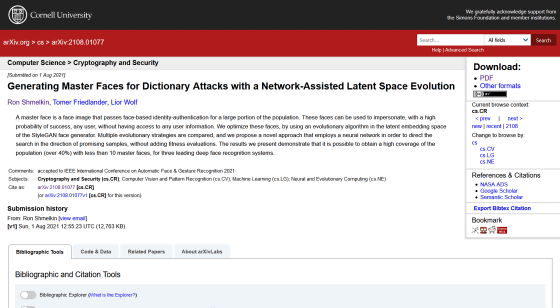Introducing AI that creates a 'master face' that is not a master key that breaks through 40% or more of face recognition with only nine faces

Face recognition systems are pervasive in many places in our daily lives, such as unlocking smartphones and PCs. However, a research team at Tel Aviv University in Israel announced that it has developed an AI that generates a 'master face' that is not a master key. It reports that it is possible to break through face recognition by impersonating more than 40% of all faces with only nine faces.
[2108.01077] Generating Master Faces for Dictionary Attacks with a Network-Assisted Latent Space Evolution

'Master Faces' That Can Bypass Over 40% Of Facial ID Authentication Systems --Unite.AI
https://www.unite.ai/master-faces-that-can-bypass-over-40-of-facial-id-authentication-systems/
The AI developed this time uses the hostile generation network ' StyleGAN ' announced by NVIDIA in December 2018 to generate a 'master face' that can break through a wide range of face recognition. In addition to StyleGAN, it also utilizes Limited-Memory Matrix Adaptation (LM-MA-ES), which is an approach for optimizing high-dimensional black boxes.
The research team uses the AI developed by the University of Massachusetts as an open source face image dataset, Labeled Faces in the Wild (LFW) , and a convolutional neural network (CNN) -based face recognition algorithm, SphereFace. Tested with FaceNet / Dlib.
AI first finds the 'most generalized features' in a wide range of face data and produces faces that impersonate as many faces as possible. Next, create a new face that impersonates as many faces as possible against the face data that could not be broken through with the first generated face. By repeating this process, it is possible to break through more face recognition with a small number of faces.
The following image is the result of testing with SphereFace (a ・ d ・ g), FaceNet (b ・ e ・ h), Dlib (c ・ f ・ i) while changing the accuracy of AI by various methods. .. There are various faces generated, but overall, 'the first face generated (which can break through the most face recognition) is an elderly white man' and 'the next face is Asian men and whites.' There is a tendency that 'there are many elderly women' and 'black faces appear after the 5th'. This tendency may reflect the facial types included in LFW.

Depending on the accuracy of the AI and the facial recognition algorithm to be tested, the research team reports that only nine facial images can break through 40-60% of facial recognition. Also, it seems that AI was able to properly capture the most generalized features from the initial stage and generate facial images, and even if the amount of training was increased, the accuracy of the system did not improve so much.
'Our results show that facial recognition is extremely vulnerable, even without information about the identity of the target,' the research team said in a treatise. As with all, there are some differences in the success rates you get. '
Related Posts:







